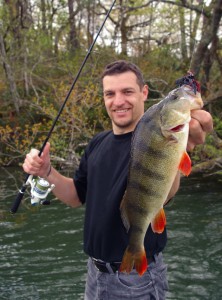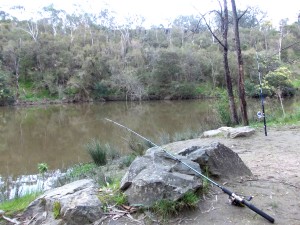Article by Ultimate Fishing (FishingTackleLures.com.au)
Fishing for redfin perch is commonplace in England and Ireland where the fish is native to the region. In their natural habitat, perch can be found in most waterways and often in large numbers. Urbanisation has lead a lot of locations in England to produce only large numbers of small perch, however it is definitely not this way in Ireland. As the rivers in Ireland are commonly well preserved, large redfin perch fishing here can be a very productive and rewarding pastime
Within Australia however, the redfin has been introduced, from linages originally from England. This does not limit their size, in fact, some very large redfin can be caught in South East Australian waters, where they are most suited to weather conditions in the southern hemisphere.
Although they are not as abundant now as they were in the past, mainly due to the overpopulation of introduced European Carp, they can still be found and caught in most waterways. Areas either without or with limited carp and tench populations tend to be home to some of the most productive and easiest redfin to catch, but access to these exact locations is often a well kept secret.

Regardless of the waterways you are trying to fish, you are most likely assured a catch of one or two redfin, the best places to target them are in lakes, dams and reservoirs. In these types of waters you can increase your chances dramatically if you are using a kayak or boat. In rivers however, it will often be a case of tracking down their location, as they often migrate in schools when in river populations.
You can almost be assured that in waters with a large number of smaller ‘bait’ fish, Redfin will often not be easy to catch. This can easily be tested by finding a somewhat weedy section of the river and swiping a landing net through the water to see what has been collected. An over abundance in food supply makes redfin take on a lethargic lifestyle, making them less likely to strike at a lure or bait. Travelling a little further out from these locations will normally be the place you will locate schools of English redfin perch.
As an ambush predator, if travelling alone they often hide at the sides of rivers, usually between fallen branches and in between weed beds. These are the best locations to try out casting some spin lures for redfin, most colours will be suitable to catch them as they tend to act mostly upon the action of the lure rather than anything else. If you are new to fishing however, bring a few spinners, because these areas are also the easiest places to get your lure caught up and snagged off.
A lot of rivers in Australia are located on private land, so bringing waders can be of a big benefit also, if you are planning to travel upstream, the 2 meters beside the river is normally classed as neutral land, meaning it is half owned by property owners, and half owned by the local waterways management (mostly privatised in Australia). Fishing however often has exemptions for river access, so provided you are accessing the waters for fishing purposes, there is little chance of any problems.
You are however, not allowed to pass beyond these 2 meters into someone’s property, unless you have express permission from the land owner. Also not allowed is any damage to foliage present near the banks of the river, along with penalties for leaving behind any rubbish. All rivers in Australia are protected environmentally, including the zone beside each river bank between the river and adjoining property (when privately owned). The rules regarding dumping of rubbish and damage to the environment are expanded when the property adjoining is owned by government agencies, to cover all government (crown) land. Crown land for fishing is strictly for access purposes only, for anyone not fishing, it is provided as recreational grounds for bush walking and other outdoor activities. Note that camping is often heavily regulated to a few small heavily restricted and designated camping locations, unfortunately camping is often not allowed on more than 99% of crown land.
Wading rivers is common in the middle of bushland or into the hills, where public access is extremely limited or no access is available. Of course wading is normally only allowed by a low depth of water, and in some deeper areas you will need to travel by the sides of the water.
Wading is something not many new fishermen consider, however it can be a very effective tool, not only as an extra way to aid travelling along rivers, but also in lakes and reservoirs, as it will allow you to walk a short distance into the waters to cast your bait or lure, giving you more range to cast into the deepest sections, areas where schools of redfin and other predatory fish are most likely to be present.

Many experienced fishermen swear by wading, even if only a short distance into the water, of course it is not recommended if you have no swimming ability, as deep pockets of water can suddenly catch you off guard.
Winter in Australia is also a time where wading, boating or using a kayak is by far the most productive method of fishing, as redfin and native Australian fish often are not as active during these colder months. They will usually be sitting in a single spot only considering a meal when one is easily presented to them. They won’t be looking to feed anywhere near as often as they would during summer months. So tracking down their location either by wading or by kayak / boat is the only productive means to catch them in wider waters during the cold or frosty days.
If wading or boating is not your kind of thing, South Eastern Australia does have their own wild populations of trout in the smaller streams and more remote reservoirs, which are most active for fishing in winter, so Redfin fishing or targeting native Australian Perch and Murray Cod can always be put on hold in order to focus on trout until summer arrives.
For fishing location information and the types of fish available, the state government fisheries department websites are a great starting point.
Australia also does not experience snow apart from on a very remote few highly positioned mountains, meaning fishing access is not restricted during the midst of winter.
In summer however, the Australian heat can serve a severe shock to the system, especially for European travellers. Between December to March, it is common to have a fair amount of 40+ degrees Celsius days, so packing a lot of water, some sun protection such as a hat and 30+ sunscreen, along with setting up under a tree in the shade if bait fishing, is always required to prevent heat stroke or other problems associated with high sun / heat exposure.